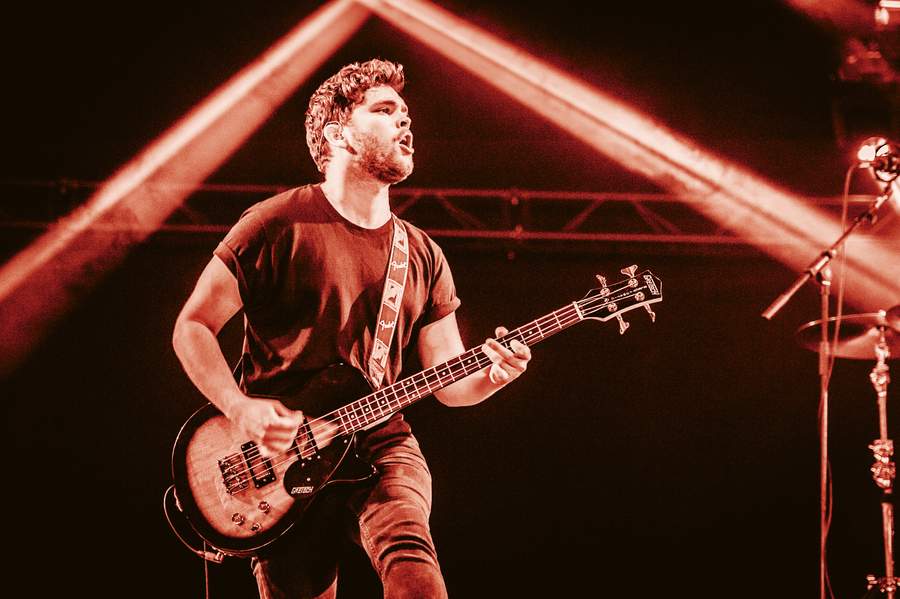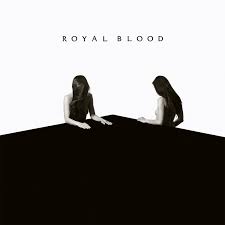Royal Blood's Mike Kerr: “I don’t talk about my pedals, ever”
The bassist–frontman half of the British power duo Royal Blood gives a coy nod to the gear used on “How Did We Get So Dark” – but don’t expect any instructional videos from this secretive player

Don’t expect any “here’s the secrets of my sound” instructional videos from Mike Kerr. The bassist–frontman half of the British power duo Royal Blood (drummer Ben Thatcher is the other half) doesn’t want anybody to know how he creates enough musical thunder to equal two or even three players.
That especially holds true for journalists nosy enough to ask him about his effects. “I’m not gonna talk about my gear,” he tells me. “I don’t talk about my pedals, ever.”
“Well, I know you use an Electro-Harmonix POG2 and a Z.Vex Mastotron Fuzz,” I venture, to which Kerr counters, “There you go then. So you know all you need to know.” I bring up the matter of Kerr’s “mystery pedal,” the identity of which he swears he’ll never disclose.
He dangles a carrot, sort of: “I could tell you, mate, but then I’d have to kill you.” Repeated attempts to wrangle more info are met with silence. In other words, “No further comment.”
Part of the reason why so many people want to divine the recipe for Kerr’s sound is he makes such an implausibly monstrous musical racket—a nearly solid-wall mix of bass and guitar tones—all by himself.
But whereas most power duos are based around the guitar-and-drums conceit, Royal Blood is a six-strings-free entity. Bass isn’t Kerr’s first instrument; the Worthing, England, native didn’t even start playing the instrument until several years ago.
He and Thatcher (who hails from the neighboring town of Rustington) had knocked around together in several bands in which he played keyboards, but after he picked up some side money to play bass on a session, Kerr decided to stick with it.
Get The Pick Newsletter
All the latest guitar news, interviews, lessons, reviews, deals and more, direct to your inbox!
“I never thought about the guitar,” he admits. “I thought the sound I got out of the bass was cool, and everybody plays guitar, so what’s new about that? There’s less to discover on the guitar, less to explore. I didn’t think there were many bass players with a cool sound, so why not give it a go?”
Royal Blood came flying out of the gate in 2014 with its self-titled debut, an action-packed winner that combined the combustible qualities of stoner rock and the low end of EDM.
But the band also had a thing for widescreen pop hooks, and tracks like “Out of the Black” and “Little Monster” brimmed with melodies that buried themselves in the thicket of your senses. Kerr and Thatcher build on that formula with their sophomore release, How Did We Get So Dark?
It hits every hit as hard as their debut, but it also offers a few new considerations: “She’s Creeping” hints at spiraling psychedelia, and “Hole in Your Heart” (on which Kerr pounds out an infectious riff on a Fender Rhodes Piano Bass) indicates that dance rhythms lurk not so deep in the hearts of the strapping, walloping duo.
“We’re trying to grow, but we want to do it naturally and honestly,” says Kerr, who allows that he’s just now coming to terms with the idea of being a bass player.
“It wasn’t really in my comfort zone at first. But here I am. I’ve done it a few years now, and I kind of feel like, ‘All right, maybe I am a bass player.’ Well, perhaps more of a bass guitarist than bass player.”
What was the first bass you picked up?
It was a Fender Precision that I borrowed off a friend, but the actual first bass I bought was my Gretsch Junior Jet. After that, I went to a Fender Starcaster. That came later, though, when we were in the studio. Initially, I was using the Junior Jet. Now I have these custom Fender Jaguars made for me, so that’s all good.
Can you describe the evolution of the sound you’ve been going for?
I won’t go into much detail. Basically, it was just about wanting to sound bigger and wanting to sound like there were more than two members, so that immediately meant I had to explore using more than one amplifier. At the same time, I didn’t want the bass to sound like the bass. I always wanted a higher edge to it. I guess I wanted to be a guitarist on the bass.
When you and Ben formed Royal Blood, did you look to other power duos as any kind of blueprint?
No, because we were searching for something that could be our own. I would always steer away from anything that sounded like other people. It’s funny, though: Now that we’ve established a sound, I’m sure there are people who will come up and copy it.
You started playing piano and keyboards early. Did you always want to be in a band?
Yeah. I started playing the piano when I was six and played keyboards up until I was 21. From the moment I learned how to play a few chords on the piano, I wanted to be in a band. That was immediate.
What kinds of bands inspired you?
I listened to the Red Hot Chili Peppers, so I probably wanted to play funk most of the time. I wasn’t into prog or anything like that. I kind of wanted the keyboards to emulate a bass sound. Before Royal Blood, I was serving as the bass player, even though I was playing the keyboards. I’ve always wanted to cover the ground in that way. And I do that on “Hole in Your Heart,” where I’m playing the Fender Rhodes Bass in kind of a Doors-type way. I just don’t like doing things the way everybody else does ’em.
Because you sing lead, do you feel as if you have to make compromises with your playing?
Obviously, playing bass and singing at the same time is a big job. I always prioritize each thing separately, and then I work at how to do them together. So there’s no compromise, really. My style is based around open playing, open riffing. You can get some big-sounding riffs by playing high up on the fretboard and using open strings. I get inspiration from guitarists, because bass players have a completely different role in a band. Like I said, I’m not really a bass player, even though I have a bass on me.
You play with a pick, right?
Oh, yeah. I don’t think I could play with my fingers. That wouldn’t give me the sound I’d want.
Do you ever think you might add another member, simply because you might want to write music that requires more than two people?
We always think about it, but we haven’t felt the need to do that. One thing we noticed in the studio was that once you start adding things, you lose other things. Sonically we take up quite a lot of room, despite the fact that it’s two of us, so there’s less room for other stuff than you might think. The kind of music we want to make is fairly minimal, and we don’t want to clutter that up, which is what other people would do.
Was your agenda for your bass sound on the new album any different from the first record?
Well, you know, I felt way more competent as a bass player toward the end of 2015 from all the touring we did. I think that affected the bass lines on the new record. They’re way harder, more complex. Not that I thought about it—I just let it happen. I was reaching for more variety in the bass tones. The first record was more meat and potatoes; this record has a few more side dishes. Production-wise, we were looking for more sophistication. The first one’s like a punch in the nose; this one’s more of a kick in the gut.
Did you use any new pieces of gear?
[Laughs.] I don’t want to say. I mean, sure, I was using more effects and gizmos. I was messing with the tone a lot.
You have kind of a squashy bass sound on a few songs, particularly on “She’s Creeping.” How are you getting that sound?
Ah, you know, a friend loaned me a couple of fuzz pedals, and they sounded cool. That’s all I’ll get into that.
For the most part, your sound blurs the lines between bass and guitar. “Lights Out,” however, is definitely more bass. Was that on purpose?
It’s all on purpose. It just felt like the right thing to do. We don’t think about things too much; it’s more like, “What does the song need?” Yeah, I think that song has more of a traditional dirty bass sound than what you usually hear in Royal Blood, so that’s why it sounds fresh.
How did playing the Fender Rhodes Piano Bass on “Hole in Your Heart” come about? Did it start out from a bass riff?
A lot of our songs are composed kind of traditionally, like at a piano or on an acoustic [guitar], but then they’ll go through the Royal Blood mill. There were some old keyboards lying around, and I started playing this vintage Bass Rhodes—it’s got, like, the bottom two octaves of a keyboard. It sounded cool, so there we were. It wasn’t like we sat down and thought, We need keyboards on the album.
Did you mostly use your custom Fender Jaguar Basses on the new album?
Yeah, most of the record was done with them. They’re short-scale, and Fender doesn’t make Jaguars with short-scale necks; thus, they’re custom. I don’t know anything about pickups, but there’s nothing gimmicky on them. They just feel good and sound good. There are two songs where I use the Starcaster because the tunings were pretty low: “Hole in Your Heart” and “Sleep.”
What did you use amp-wise?
Fender Super-Sonics and Bassmans. I used to use Ampeg GVTs and SVTs, but they’re hard to get hold of and not as practical to use. Fender was kind enough to supply us with Super-Sonics, and then we ended up buying a load. I prefer them, really. They have a boxier sound that I like.
How much practicing do you do on the bass?
I play every day, and I usually spend an hour playing at soundcheck, trying stuff out. I spend my time composing, so I’m sort of practicing, anyway. But I don’t go, “Oh, it’s 8 PM—time for practice.” I don’t really know any scales on the bass, and I almost don’t want to know. I think my initial creativity on the bass was because I didn’t know what I was doing. A lot of creativity comes out of lack of knowledge or naiveté. So I just want to keep enjoying playing and make sure that I’m playing for myself.
Info

LISTEN
With Royal Blood How Did We Get So Dark? [2017, Warner Bros.], Royal Blood [2014, Warner Bros.]
EQUIP
Basses Fender custom Jaguar Basses, Fender Starcaster Amps Fender Super-Sonic 22 combo amps, Fender Super Bassman head, Fender Bassman 810 Neo cabinet Effects Electro-Harmonix POG2 Polyphonic Octave Generator, Z.Vex Vextron Series Mastotron, Boss LS-2 Line Selector, Boss PS-6 Harmonist, Strymon Flint Tremolo & Reverb Strings D’Addario EXL180, EXL170S, EXL220S, EXL165, EXL160S and custom set (.075, .095, XLB. 020P, XLB .018P)
Joe is a freelance journalist who has, over the past few decades, interviewed hundreds of guitarists for Guitar World, Guitar Player, MusicRadar and Classic Rock. He is also a former editor of Guitar World, contributing writer for Guitar Aficionado and VP of A&R for Island Records. He’s an enthusiastic guitarist, but he’s nowhere near the likes of the people he interviews. Surprisingly, his skills are more suited to the drums. If you need a drummer for your Beatles tribute band, look him up.











